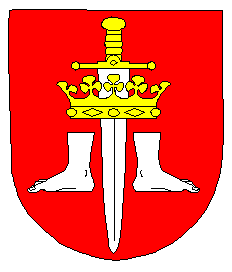Illuka
| Heraldry of the World Civic heraldry of Estonia |
ILLUKA
County: Ida-Virumaa
Official blazon
Punase kilbi keskel allasuunatud hõbedase tera ja kuldse käepidemega mõõk, saatena säärest äralõigatud labajalad 1 + 1, varbad väljapoole. Jalgade kohal mõõgast läbistatud kuldne viie kolmiklehega kroon.
Origin/meaning
The arms were officially granted on November 29, 1993.
The arms refer to Kalev's son, the national hero according to the Kalevipoeg epic history. The story tells about Kalevipoeg :
Kalevipoeg travels to Finland in search of his kidnapped mother. During his travel he purchases a sword but kills the blacksmith's eldest son in an argument. The blacksmith places a curse on the sword and is thrown in the river. On returning to Estonia Kalevipoeg becomes king after defeating his brothers in a stone hurling competition. He constructs towns and forts and tills the land in Estonia. Kalevipoeg then journeys to the ends of the earth to expand his knowledge. He defeats Satan in a trial of strength and rescues three maidens from hell. War breaks out and destruction visits Estonia and Kalevipoeg's faithful comrades are killed, he hands rule over to his brother Olev and withdraws to the forest depressed. Crossing a river, the sword cursed by the Blacksmith and previously thrown in the river, cuts off his legs. He dies and goes to heaven. Taara, in consultation with the other gods, reanimate Kalevipoeg and place his legless body on a white stead and send him down to the gates of hell where they order him to strike the rock with his fist. His fist becomes trapped in the rock and thus he remains to guard the gates of hell.
Literature : Image taken from http://valitsus.ee/et/riigikantselei/riigi-ja-omavalitsuste-symbolid/ and Troels P. Roland. Summary from wikipedia
